Management Perspective Report: Self-Assessment and Analysis
VerifiedAdded on 2022/12/26
|8
|2986
|56
Report
AI Summary
This report presents a management perspective analysis based on a self-assessment and a case study of Woolworths. The author, identifying as an ISTJ personality type, conducts a SWOT analysis to evaluate their strengths, weaknesses, opportunities, and threats in a professional context. The report examines the nature of naturally occurring data and its application in understanding organizational behavior, referencing the Woolworths case to illustrate ethical issues related to underpaid cleaning staff. The author assesses their personal strengths and weaknesses in relation to the organization and evaluates their placement within the company. The report also addresses self-improvement strategies for continuous development, emphasizing the importance of seeking assistance, taking initiative, and eliminating procrastination. Overall, the report provides a comprehensive analysis of management perspectives, incorporating personal reflection, organizational analysis, and strategies for professional growth.
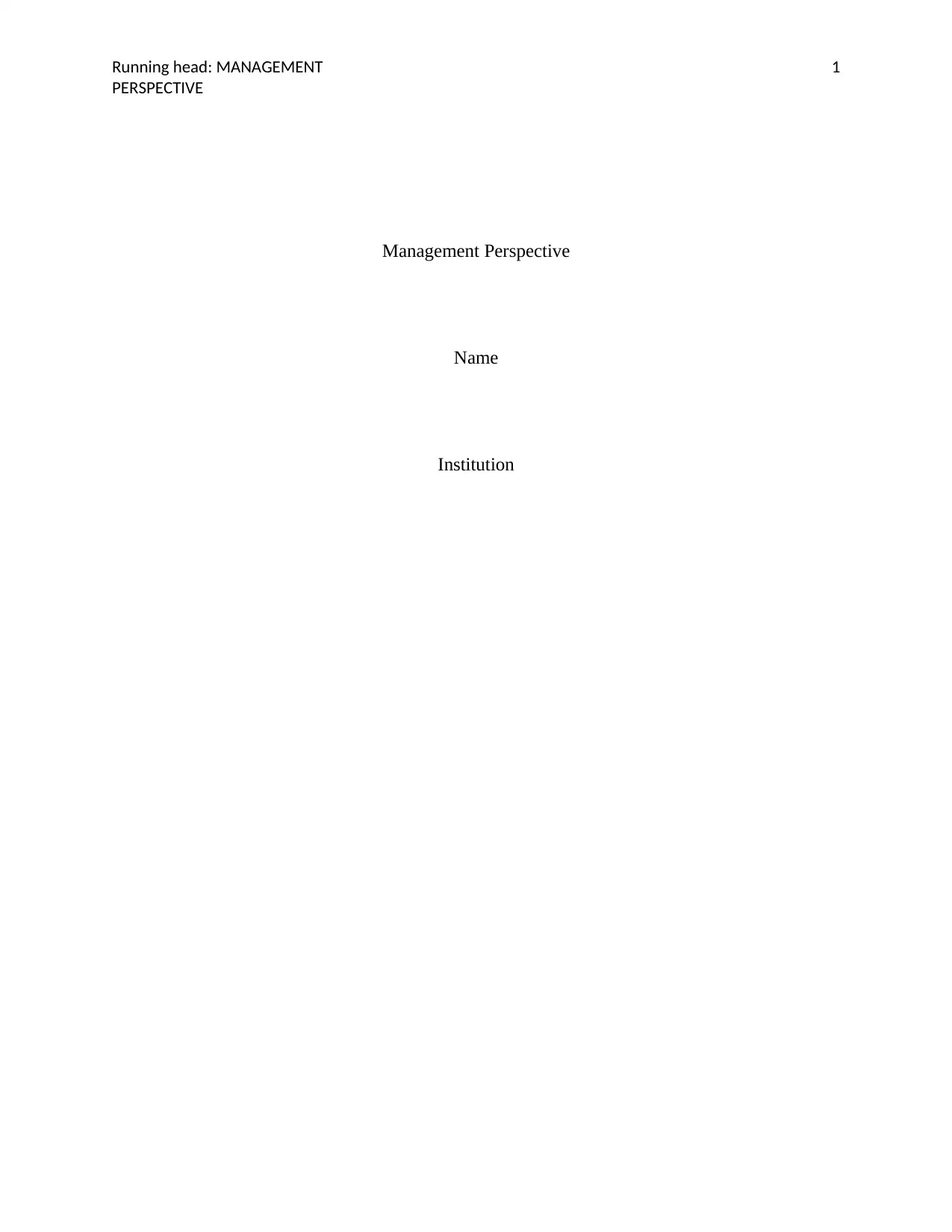
Running head: MANAGEMENT
PERSPECTIVE
1
Management Perspective
Name
Institution
PERSPECTIVE
1
Management Perspective
Name
Institution
Paraphrase This Document
Need a fresh take? Get an instant paraphrase of this document with our AI Paraphraser
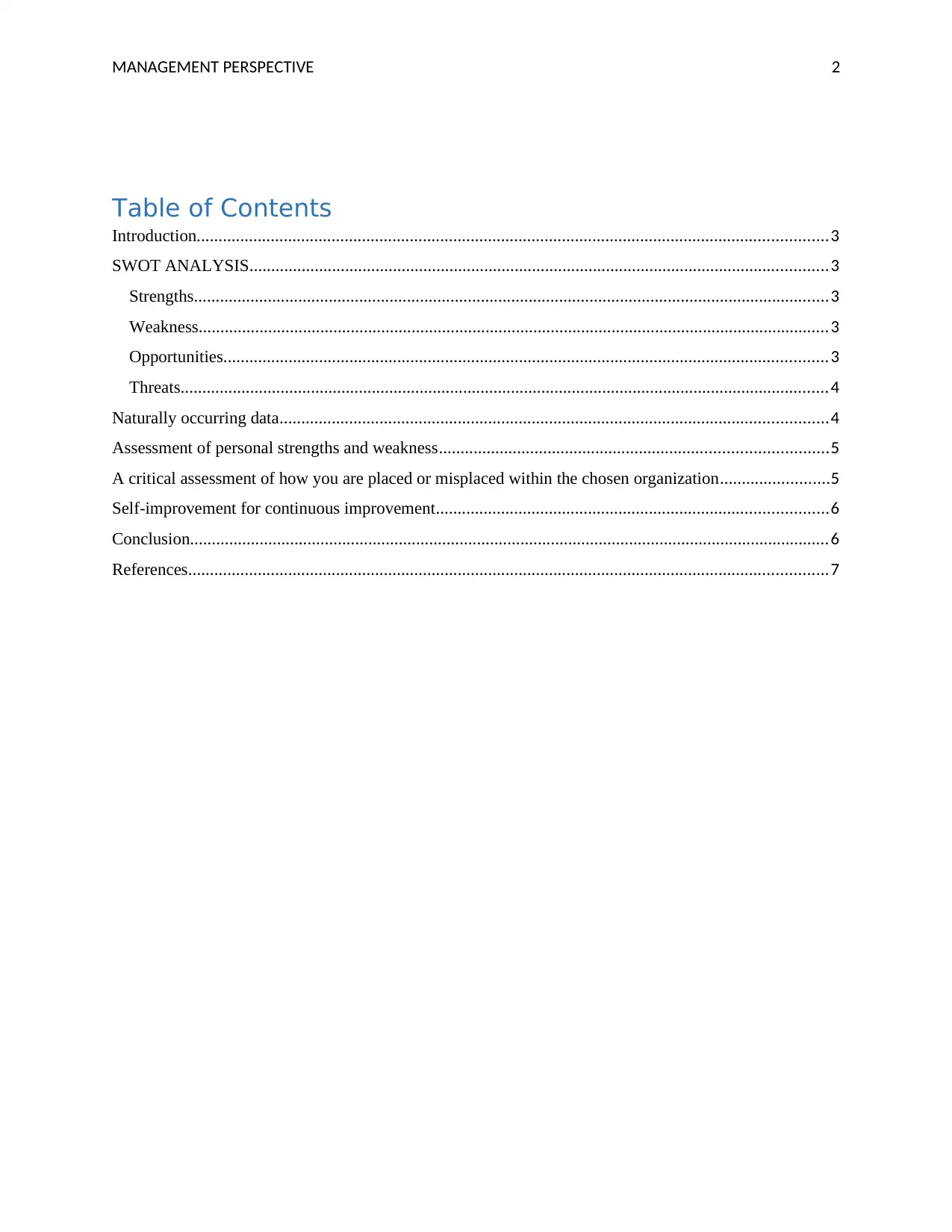
MANAGEMENT PERSPECTIVE 2
Table of Contents
Introduction.................................................................................................................................................3
SWOT ANALYSIS.....................................................................................................................................3
Strengths..................................................................................................................................................3
Weakness.................................................................................................................................................3
Opportunities...........................................................................................................................................3
Threats.....................................................................................................................................................4
Naturally occurring data..............................................................................................................................4
Assessment of personal strengths and weakness.........................................................................................5
A critical assessment of how you are placed or misplaced within the chosen organization.........................5
Self-improvement for continuous improvement..........................................................................................6
Conclusion...................................................................................................................................................6
References...................................................................................................................................................7
Table of Contents
Introduction.................................................................................................................................................3
SWOT ANALYSIS.....................................................................................................................................3
Strengths..................................................................................................................................................3
Weakness.................................................................................................................................................3
Opportunities...........................................................................................................................................3
Threats.....................................................................................................................................................4
Naturally occurring data..............................................................................................................................4
Assessment of personal strengths and weakness.........................................................................................5
A critical assessment of how you are placed or misplaced within the chosen organization.........................5
Self-improvement for continuous improvement..........................................................................................6
Conclusion...................................................................................................................................................6
References...................................................................................................................................................7

MANAGEMENT PERSPECTIVE 3
Introduction.
After undertaking the Myers-Briggs personality type indicator test I came to the realization that
my personality type is ISTJ which stands for Introvert, Sensing, Thinking and Judgment (Brown
& Reilly, 2009). I scored 31%, 3%, 47% and 9% respectively. This means that I have a
reasonable inclination toward introversion than extroversion, a marginal or no preference of
sensing over intuition, a moderate preference of thinking over feeling and a slight preference of
judging over perceiving (Kuipers et al, 2009). Individuals who have this personality type
inclusive of myself are also referred to as inspectors due to our strong sense of what is correct
and erroneous, especially if it is in our area of specialization or it is our responsibility. We are
also very dedicated to our work. This personality type is more often than not given the
impression of being aloof and at times cold (Johnston et al, 2009). We do not express our
emotions all the time due to our mastery of the same. As a result of our natural strengths, we
normally find ourselves in jobs that involve monitoring of the production process effectiveness.
We are very detail oriented and our formulation of plans is clear-cut. After consideration and
analysis of my personality traits, I developed the personal SWOT analysis below (Helms &
Nixon, 2010)
SWOT ANALYSIS.
Strengths
I have an acute understanding of what is right and wrong.
I am very devoted to my duties.
I am objective, I look at a problem and find a solution using reasoning and analysis and
very little using emotions.
I am very methodological when approaching and dealing with a problem which is a trait
that is not common among many employees.
I am time oriented and true to my word as evidenced by the lack of any complaints from
my peers regarding failures to hold up to my commitments.
Weakness
I am not good at negotiations since I prefer my ways to be followed.
As a result of my introvert nature, I am more silent in the office and rarely attend office
functions of an informal nature.
I require more training in personnel management and communication skills since I have
difficulty in dealing with other people and understanding their needs and wants.
I am very logical and concepts like “going with my gut” makes no sense hence split,-
second decision making is a very difficult process for me.
Opportunities
Due to the introduction of fast internet and e-commerce, the sharing of ideas among my
peers in the office will greatly assist in my personal development.
The food industry is growing, this will have the effect of opening up new job positions
and opportunities hence there will be more promotions.
Introduction.
After undertaking the Myers-Briggs personality type indicator test I came to the realization that
my personality type is ISTJ which stands for Introvert, Sensing, Thinking and Judgment (Brown
& Reilly, 2009). I scored 31%, 3%, 47% and 9% respectively. This means that I have a
reasonable inclination toward introversion than extroversion, a marginal or no preference of
sensing over intuition, a moderate preference of thinking over feeling and a slight preference of
judging over perceiving (Kuipers et al, 2009). Individuals who have this personality type
inclusive of myself are also referred to as inspectors due to our strong sense of what is correct
and erroneous, especially if it is in our area of specialization or it is our responsibility. We are
also very dedicated to our work. This personality type is more often than not given the
impression of being aloof and at times cold (Johnston et al, 2009). We do not express our
emotions all the time due to our mastery of the same. As a result of our natural strengths, we
normally find ourselves in jobs that involve monitoring of the production process effectiveness.
We are very detail oriented and our formulation of plans is clear-cut. After consideration and
analysis of my personality traits, I developed the personal SWOT analysis below (Helms &
Nixon, 2010)
SWOT ANALYSIS.
Strengths
I have an acute understanding of what is right and wrong.
I am very devoted to my duties.
I am objective, I look at a problem and find a solution using reasoning and analysis and
very little using emotions.
I am very methodological when approaching and dealing with a problem which is a trait
that is not common among many employees.
I am time oriented and true to my word as evidenced by the lack of any complaints from
my peers regarding failures to hold up to my commitments.
Weakness
I am not good at negotiations since I prefer my ways to be followed.
As a result of my introvert nature, I am more silent in the office and rarely attend office
functions of an informal nature.
I require more training in personnel management and communication skills since I have
difficulty in dealing with other people and understanding their needs and wants.
I am very logical and concepts like “going with my gut” makes no sense hence split,-
second decision making is a very difficult process for me.
Opportunities
Due to the introduction of fast internet and e-commerce, the sharing of ideas among my
peers in the office will greatly assist in my personal development.
The food industry is growing, this will have the effect of opening up new job positions
and opportunities hence there will be more promotions.
⊘ This is a preview!⊘
Do you want full access?
Subscribe today to unlock all pages.

Trusted by 1+ million students worldwide
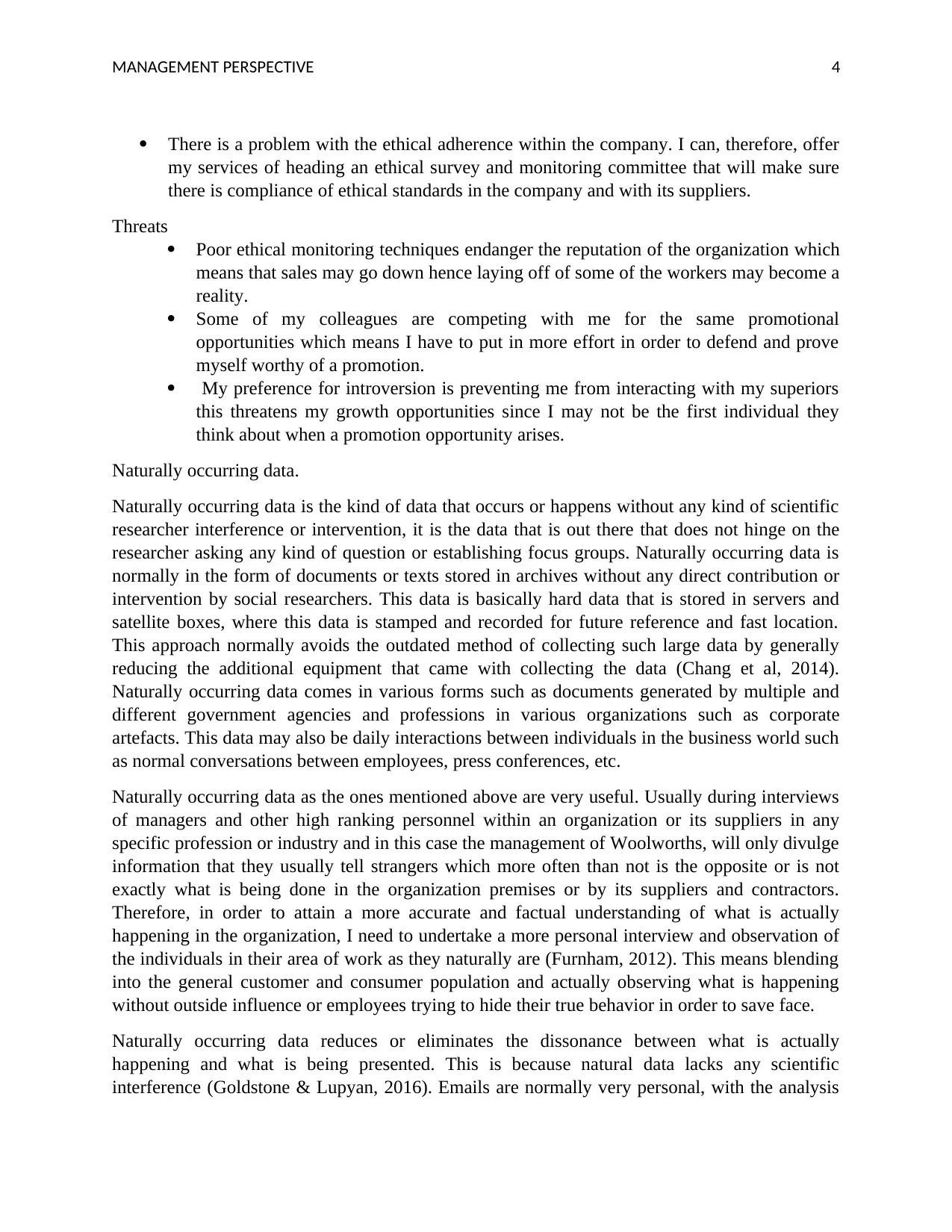
MANAGEMENT PERSPECTIVE 4
There is a problem with the ethical adherence within the company. I can, therefore, offer
my services of heading an ethical survey and monitoring committee that will make sure
there is compliance of ethical standards in the company and with its suppliers.
Threats
Poor ethical monitoring techniques endanger the reputation of the organization which
means that sales may go down hence laying off of some of the workers may become a
reality.
Some of my colleagues are competing with me for the same promotional
opportunities which means I have to put in more effort in order to defend and prove
myself worthy of a promotion.
My preference for introversion is preventing me from interacting with my superiors
this threatens my growth opportunities since I may not be the first individual they
think about when a promotion opportunity arises.
Naturally occurring data.
Naturally occurring data is the kind of data that occurs or happens without any kind of scientific
researcher interference or intervention, it is the data that is out there that does not hinge on the
researcher asking any kind of question or establishing focus groups. Naturally occurring data is
normally in the form of documents or texts stored in archives without any direct contribution or
intervention by social researchers. This data is basically hard data that is stored in servers and
satellite boxes, where this data is stamped and recorded for future reference and fast location.
This approach normally avoids the outdated method of collecting such large data by generally
reducing the additional equipment that came with collecting the data (Chang et al, 2014).
Naturally occurring data comes in various forms such as documents generated by multiple and
different government agencies and professions in various organizations such as corporate
artefacts. This data may also be daily interactions between individuals in the business world such
as normal conversations between employees, press conferences, etc.
Naturally occurring data as the ones mentioned above are very useful. Usually during interviews
of managers and other high ranking personnel within an organization or its suppliers in any
specific profession or industry and in this case the management of Woolworths, will only divulge
information that they usually tell strangers which more often than not is the opposite or is not
exactly what is being done in the organization premises or by its suppliers and contractors.
Therefore, in order to attain a more accurate and factual understanding of what is actually
happening in the organization, I need to undertake a more personal interview and observation of
the individuals in their area of work as they naturally are (Furnham, 2012). This means blending
into the general customer and consumer population and actually observing what is happening
without outside influence or employees trying to hide their true behavior in order to save face.
Naturally occurring data reduces or eliminates the dissonance between what is actually
happening and what is being presented. This is because natural data lacks any scientific
interference (Goldstone & Lupyan, 2016). Emails are normally very personal, with the analysis
There is a problem with the ethical adherence within the company. I can, therefore, offer
my services of heading an ethical survey and monitoring committee that will make sure
there is compliance of ethical standards in the company and with its suppliers.
Threats
Poor ethical monitoring techniques endanger the reputation of the organization which
means that sales may go down hence laying off of some of the workers may become a
reality.
Some of my colleagues are competing with me for the same promotional
opportunities which means I have to put in more effort in order to defend and prove
myself worthy of a promotion.
My preference for introversion is preventing me from interacting with my superiors
this threatens my growth opportunities since I may not be the first individual they
think about when a promotion opportunity arises.
Naturally occurring data.
Naturally occurring data is the kind of data that occurs or happens without any kind of scientific
researcher interference or intervention, it is the data that is out there that does not hinge on the
researcher asking any kind of question or establishing focus groups. Naturally occurring data is
normally in the form of documents or texts stored in archives without any direct contribution or
intervention by social researchers. This data is basically hard data that is stored in servers and
satellite boxes, where this data is stamped and recorded for future reference and fast location.
This approach normally avoids the outdated method of collecting such large data by generally
reducing the additional equipment that came with collecting the data (Chang et al, 2014).
Naturally occurring data comes in various forms such as documents generated by multiple and
different government agencies and professions in various organizations such as corporate
artefacts. This data may also be daily interactions between individuals in the business world such
as normal conversations between employees, press conferences, etc.
Naturally occurring data as the ones mentioned above are very useful. Usually during interviews
of managers and other high ranking personnel within an organization or its suppliers in any
specific profession or industry and in this case the management of Woolworths, will only divulge
information that they usually tell strangers which more often than not is the opposite or is not
exactly what is being done in the organization premises or by its suppliers and contractors.
Therefore, in order to attain a more accurate and factual understanding of what is actually
happening in the organization, I need to undertake a more personal interview and observation of
the individuals in their area of work as they naturally are (Furnham, 2012). This means blending
into the general customer and consumer population and actually observing what is happening
without outside influence or employees trying to hide their true behavior in order to save face.
Naturally occurring data reduces or eliminates the dissonance between what is actually
happening and what is being presented. This is because natural data lacks any scientific
interference (Goldstone & Lupyan, 2016). Emails are normally very personal, with the analysis
Paraphrase This Document
Need a fresh take? Get an instant paraphrase of this document with our AI Paraphraser
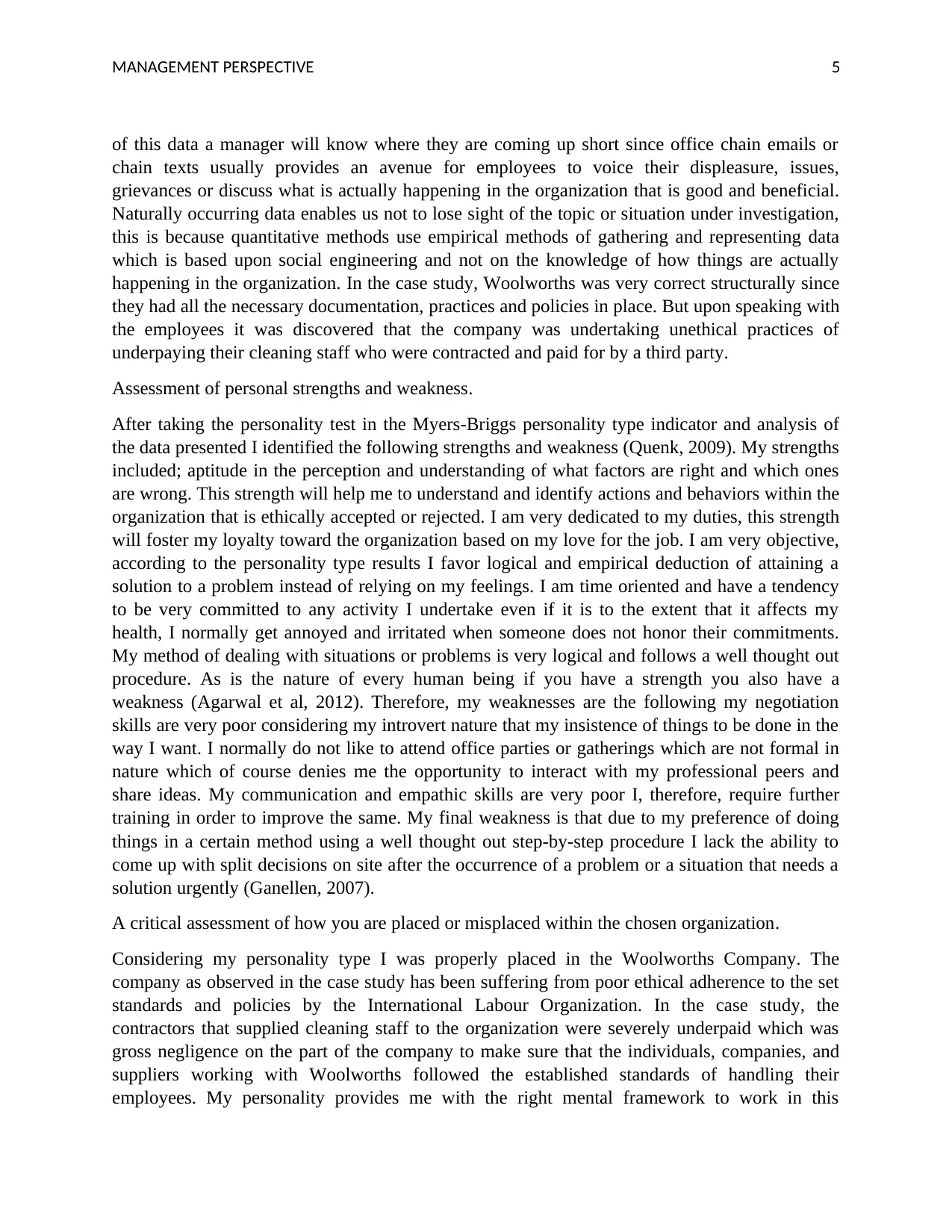
MANAGEMENT PERSPECTIVE 5
of this data a manager will know where they are coming up short since office chain emails or
chain texts usually provides an avenue for employees to voice their displeasure, issues,
grievances or discuss what is actually happening in the organization that is good and beneficial.
Naturally occurring data enables us not to lose sight of the topic or situation under investigation,
this is because quantitative methods use empirical methods of gathering and representing data
which is based upon social engineering and not on the knowledge of how things are actually
happening in the organization. In the case study, Woolworths was very correct structurally since
they had all the necessary documentation, practices and policies in place. But upon speaking with
the employees it was discovered that the company was undertaking unethical practices of
underpaying their cleaning staff who were contracted and paid for by a third party.
Assessment of personal strengths and weakness.
After taking the personality test in the Myers-Briggs personality type indicator and analysis of
the data presented I identified the following strengths and weakness (Quenk, 2009). My strengths
included; aptitude in the perception and understanding of what factors are right and which ones
are wrong. This strength will help me to understand and identify actions and behaviors within the
organization that is ethically accepted or rejected. I am very dedicated to my duties, this strength
will foster my loyalty toward the organization based on my love for the job. I am very objective,
according to the personality type results I favor logical and empirical deduction of attaining a
solution to a problem instead of relying on my feelings. I am time oriented and have a tendency
to be very committed to any activity I undertake even if it is to the extent that it affects my
health, I normally get annoyed and irritated when someone does not honor their commitments.
My method of dealing with situations or problems is very logical and follows a well thought out
procedure. As is the nature of every human being if you have a strength you also have a
weakness (Agarwal et al, 2012). Therefore, my weaknesses are the following my negotiation
skills are very poor considering my introvert nature that my insistence of things to be done in the
way I want. I normally do not like to attend office parties or gatherings which are not formal in
nature which of course denies me the opportunity to interact with my professional peers and
share ideas. My communication and empathic skills are very poor I, therefore, require further
training in order to improve the same. My final weakness is that due to my preference of doing
things in a certain method using a well thought out step-by-step procedure I lack the ability to
come up with split decisions on site after the occurrence of a problem or a situation that needs a
solution urgently (Ganellen, 2007).
A critical assessment of how you are placed or misplaced within the chosen organization.
Considering my personality type I was properly placed in the Woolworths Company. The
company as observed in the case study has been suffering from poor ethical adherence to the set
standards and policies by the International Labour Organization. In the case study, the
contractors that supplied cleaning staff to the organization were severely underpaid which was
gross negligence on the part of the company to make sure that the individuals, companies, and
suppliers working with Woolworths followed the established standards of handling their
employees. My personality provides me with the right mental framework to work in this
of this data a manager will know where they are coming up short since office chain emails or
chain texts usually provides an avenue for employees to voice their displeasure, issues,
grievances or discuss what is actually happening in the organization that is good and beneficial.
Naturally occurring data enables us not to lose sight of the topic or situation under investigation,
this is because quantitative methods use empirical methods of gathering and representing data
which is based upon social engineering and not on the knowledge of how things are actually
happening in the organization. In the case study, Woolworths was very correct structurally since
they had all the necessary documentation, practices and policies in place. But upon speaking with
the employees it was discovered that the company was undertaking unethical practices of
underpaying their cleaning staff who were contracted and paid for by a third party.
Assessment of personal strengths and weakness.
After taking the personality test in the Myers-Briggs personality type indicator and analysis of
the data presented I identified the following strengths and weakness (Quenk, 2009). My strengths
included; aptitude in the perception and understanding of what factors are right and which ones
are wrong. This strength will help me to understand and identify actions and behaviors within the
organization that is ethically accepted or rejected. I am very dedicated to my duties, this strength
will foster my loyalty toward the organization based on my love for the job. I am very objective,
according to the personality type results I favor logical and empirical deduction of attaining a
solution to a problem instead of relying on my feelings. I am time oriented and have a tendency
to be very committed to any activity I undertake even if it is to the extent that it affects my
health, I normally get annoyed and irritated when someone does not honor their commitments.
My method of dealing with situations or problems is very logical and follows a well thought out
procedure. As is the nature of every human being if you have a strength you also have a
weakness (Agarwal et al, 2012). Therefore, my weaknesses are the following my negotiation
skills are very poor considering my introvert nature that my insistence of things to be done in the
way I want. I normally do not like to attend office parties or gatherings which are not formal in
nature which of course denies me the opportunity to interact with my professional peers and
share ideas. My communication and empathic skills are very poor I, therefore, require further
training in order to improve the same. My final weakness is that due to my preference of doing
things in a certain method using a well thought out step-by-step procedure I lack the ability to
come up with split decisions on site after the occurrence of a problem or a situation that needs a
solution urgently (Ganellen, 2007).
A critical assessment of how you are placed or misplaced within the chosen organization.
Considering my personality type I was properly placed in the Woolworths Company. The
company as observed in the case study has been suffering from poor ethical adherence to the set
standards and policies by the International Labour Organization. In the case study, the
contractors that supplied cleaning staff to the organization were severely underpaid which was
gross negligence on the part of the company to make sure that the individuals, companies, and
suppliers working with Woolworths followed the established standards of handling their
employees. My personality provides me with the right mental framework to work in this
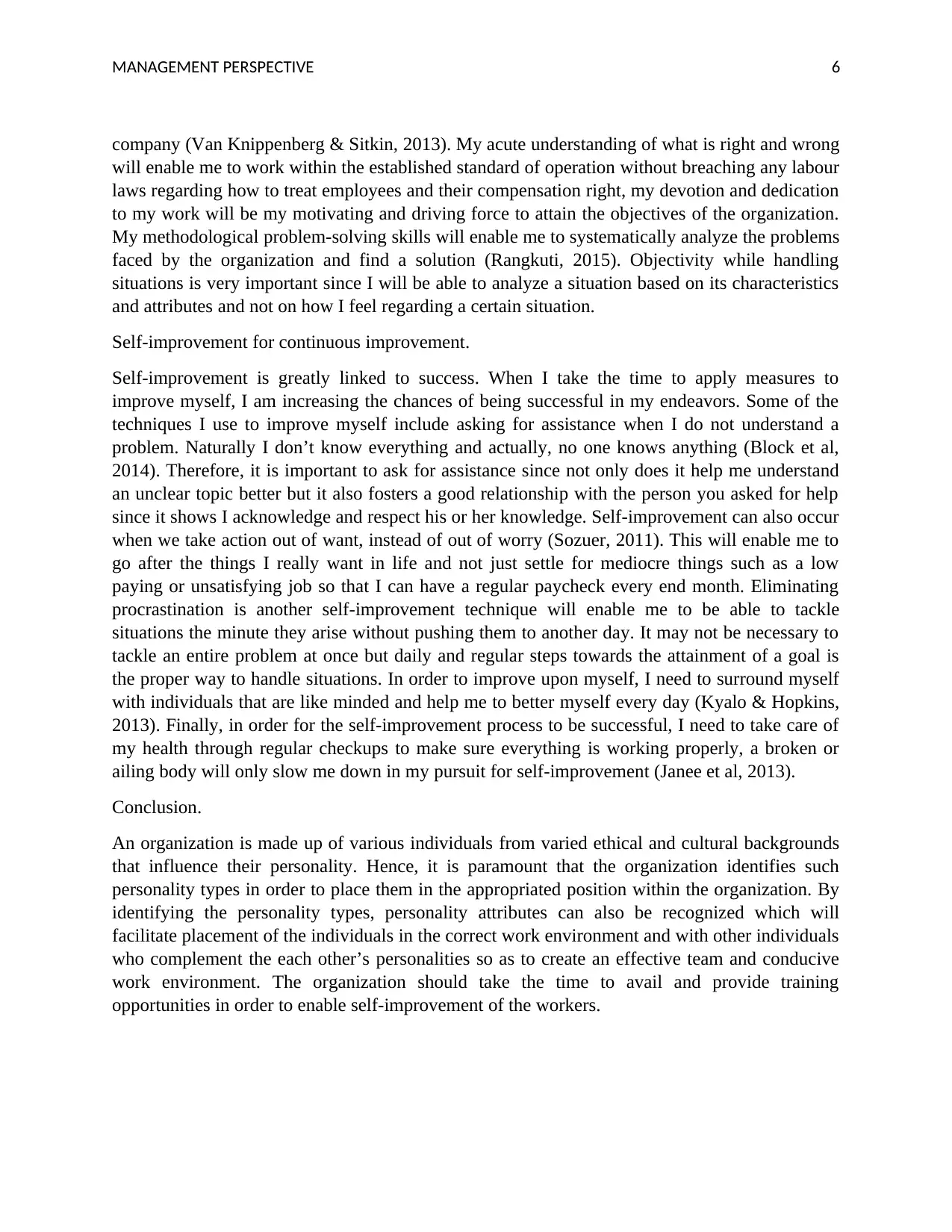
MANAGEMENT PERSPECTIVE 6
company (Van Knippenberg & Sitkin, 2013). My acute understanding of what is right and wrong
will enable me to work within the established standard of operation without breaching any labour
laws regarding how to treat employees and their compensation right, my devotion and dedication
to my work will be my motivating and driving force to attain the objectives of the organization.
My methodological problem-solving skills will enable me to systematically analyze the problems
faced by the organization and find a solution (Rangkuti, 2015). Objectivity while handling
situations is very important since I will be able to analyze a situation based on its characteristics
and attributes and not on how I feel regarding a certain situation.
Self-improvement for continuous improvement.
Self-improvement is greatly linked to success. When I take the time to apply measures to
improve myself, I am increasing the chances of being successful in my endeavors. Some of the
techniques I use to improve myself include asking for assistance when I do not understand a
problem. Naturally I don’t know everything and actually, no one knows anything (Block et al,
2014). Therefore, it is important to ask for assistance since not only does it help me understand
an unclear topic better but it also fosters a good relationship with the person you asked for help
since it shows I acknowledge and respect his or her knowledge. Self-improvement can also occur
when we take action out of want, instead of out of worry (Sozuer, 2011). This will enable me to
go after the things I really want in life and not just settle for mediocre things such as a low
paying or unsatisfying job so that I can have a regular paycheck every end month. Eliminating
procrastination is another self-improvement technique will enable me to be able to tackle
situations the minute they arise without pushing them to another day. It may not be necessary to
tackle an entire problem at once but daily and regular steps towards the attainment of a goal is
the proper way to handle situations. In order to improve upon myself, I need to surround myself
with individuals that are like minded and help me to better myself every day (Kyalo & Hopkins,
2013). Finally, in order for the self-improvement process to be successful, I need to take care of
my health through regular checkups to make sure everything is working properly, a broken or
ailing body will only slow me down in my pursuit for self-improvement (Janee et al, 2013).
Conclusion.
An organization is made up of various individuals from varied ethical and cultural backgrounds
that influence their personality. Hence, it is paramount that the organization identifies such
personality types in order to place them in the appropriated position within the organization. By
identifying the personality types, personality attributes can also be recognized which will
facilitate placement of the individuals in the correct work environment and with other individuals
who complement the each other’s personalities so as to create an effective team and conducive
work environment. The organization should take the time to avail and provide training
opportunities in order to enable self-improvement of the workers.
company (Van Knippenberg & Sitkin, 2013). My acute understanding of what is right and wrong
will enable me to work within the established standard of operation without breaching any labour
laws regarding how to treat employees and their compensation right, my devotion and dedication
to my work will be my motivating and driving force to attain the objectives of the organization.
My methodological problem-solving skills will enable me to systematically analyze the problems
faced by the organization and find a solution (Rangkuti, 2015). Objectivity while handling
situations is very important since I will be able to analyze a situation based on its characteristics
and attributes and not on how I feel regarding a certain situation.
Self-improvement for continuous improvement.
Self-improvement is greatly linked to success. When I take the time to apply measures to
improve myself, I am increasing the chances of being successful in my endeavors. Some of the
techniques I use to improve myself include asking for assistance when I do not understand a
problem. Naturally I don’t know everything and actually, no one knows anything (Block et al,
2014). Therefore, it is important to ask for assistance since not only does it help me understand
an unclear topic better but it also fosters a good relationship with the person you asked for help
since it shows I acknowledge and respect his or her knowledge. Self-improvement can also occur
when we take action out of want, instead of out of worry (Sozuer, 2011). This will enable me to
go after the things I really want in life and not just settle for mediocre things such as a low
paying or unsatisfying job so that I can have a regular paycheck every end month. Eliminating
procrastination is another self-improvement technique will enable me to be able to tackle
situations the minute they arise without pushing them to another day. It may not be necessary to
tackle an entire problem at once but daily and regular steps towards the attainment of a goal is
the proper way to handle situations. In order to improve upon myself, I need to surround myself
with individuals that are like minded and help me to better myself every day (Kyalo & Hopkins,
2013). Finally, in order for the self-improvement process to be successful, I need to take care of
my health through regular checkups to make sure everything is working properly, a broken or
ailing body will only slow me down in my pursuit for self-improvement (Janee et al, 2013).
Conclusion.
An organization is made up of various individuals from varied ethical and cultural backgrounds
that influence their personality. Hence, it is paramount that the organization identifies such
personality types in order to place them in the appropriated position within the organization. By
identifying the personality types, personality attributes can also be recognized which will
facilitate placement of the individuals in the correct work environment and with other individuals
who complement the each other’s personalities so as to create an effective team and conducive
work environment. The organization should take the time to avail and provide training
opportunities in order to enable self-improvement of the workers.
⊘ This is a preview!⊘
Do you want full access?
Subscribe today to unlock all pages.

Trusted by 1+ million students worldwide
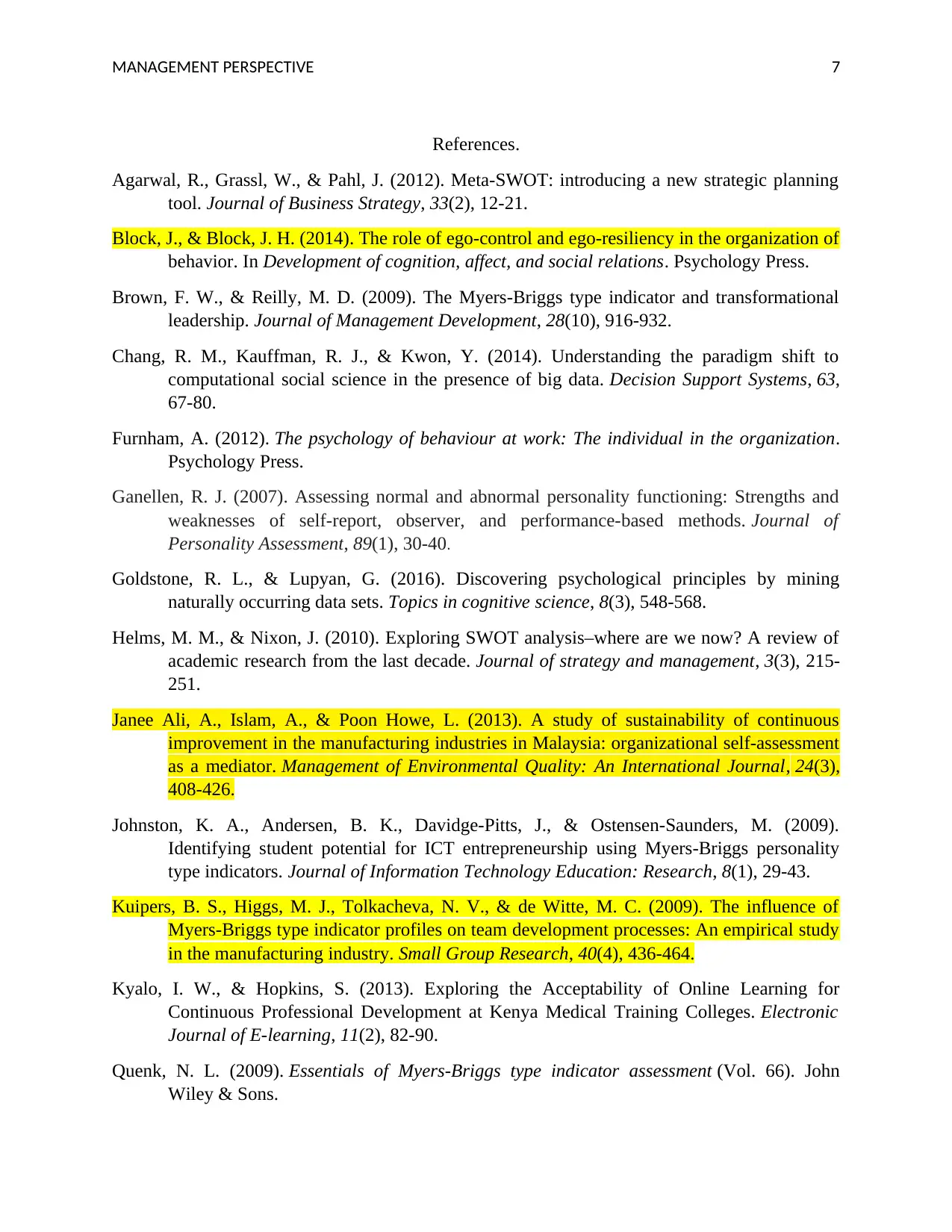
MANAGEMENT PERSPECTIVE 7
References.
Agarwal, R., Grassl, W., & Pahl, J. (2012). Meta-SWOT: introducing a new strategic planning
tool. Journal of Business Strategy, 33(2), 12-21.
Block, J., & Block, J. H. (2014). The role of ego-control and ego-resiliency in the organization of
behavior. In Development of cognition, affect, and social relations. Psychology Press.
Brown, F. W., & Reilly, M. D. (2009). The Myers-Briggs type indicator and transformational
leadership. Journal of Management Development, 28(10), 916-932.
Chang, R. M., Kauffman, R. J., & Kwon, Y. (2014). Understanding the paradigm shift to
computational social science in the presence of big data. Decision Support Systems, 63,
67-80.
Furnham, A. (2012). The psychology of behaviour at work: The individual in the organization.
Psychology Press.
Ganellen, R. J. (2007). Assessing normal and abnormal personality functioning: Strengths and
weaknesses of self-report, observer, and performance-based methods. Journal of
Personality Assessment, 89(1), 30-40.
Goldstone, R. L., & Lupyan, G. (2016). Discovering psychological principles by mining
naturally occurring data sets. Topics in cognitive science, 8(3), 548-568.
Helms, M. M., & Nixon, J. (2010). Exploring SWOT analysis–where are we now? A review of
academic research from the last decade. Journal of strategy and management, 3(3), 215-
251.
Janee Ali, A., Islam, A., & Poon Howe, L. (2013). A study of sustainability of continuous
improvement in the manufacturing industries in Malaysia: organizational self-assessment
as a mediator. Management of Environmental Quality: An International Journal, 24(3),
408-426.
Johnston, K. A., Andersen, B. K., Davidge-Pitts, J., & Ostensen-Saunders, M. (2009).
Identifying student potential for ICT entrepreneurship using Myers-Briggs personality
type indicators. Journal of Information Technology Education: Research, 8(1), 29-43.
Kuipers, B. S., Higgs, M. J., Tolkacheva, N. V., & de Witte, M. C. (2009). The influence of
Myers-Briggs type indicator profiles on team development processes: An empirical study
in the manufacturing industry. Small Group Research, 40(4), 436-464.
Kyalo, I. W., & Hopkins, S. (2013). Exploring the Acceptability of Online Learning for
Continuous Professional Development at Kenya Medical Training Colleges. Electronic
Journal of E-learning, 11(2), 82-90.
Quenk, N. L. (2009). Essentials of Myers-Briggs type indicator assessment (Vol. 66). John
Wiley & Sons.
References.
Agarwal, R., Grassl, W., & Pahl, J. (2012). Meta-SWOT: introducing a new strategic planning
tool. Journal of Business Strategy, 33(2), 12-21.
Block, J., & Block, J. H. (2014). The role of ego-control and ego-resiliency in the organization of
behavior. In Development of cognition, affect, and social relations. Psychology Press.
Brown, F. W., & Reilly, M. D. (2009). The Myers-Briggs type indicator and transformational
leadership. Journal of Management Development, 28(10), 916-932.
Chang, R. M., Kauffman, R. J., & Kwon, Y. (2014). Understanding the paradigm shift to
computational social science in the presence of big data. Decision Support Systems, 63,
67-80.
Furnham, A. (2012). The psychology of behaviour at work: The individual in the organization.
Psychology Press.
Ganellen, R. J. (2007). Assessing normal and abnormal personality functioning: Strengths and
weaknesses of self-report, observer, and performance-based methods. Journal of
Personality Assessment, 89(1), 30-40.
Goldstone, R. L., & Lupyan, G. (2016). Discovering psychological principles by mining
naturally occurring data sets. Topics in cognitive science, 8(3), 548-568.
Helms, M. M., & Nixon, J. (2010). Exploring SWOT analysis–where are we now? A review of
academic research from the last decade. Journal of strategy and management, 3(3), 215-
251.
Janee Ali, A., Islam, A., & Poon Howe, L. (2013). A study of sustainability of continuous
improvement in the manufacturing industries in Malaysia: organizational self-assessment
as a mediator. Management of Environmental Quality: An International Journal, 24(3),
408-426.
Johnston, K. A., Andersen, B. K., Davidge-Pitts, J., & Ostensen-Saunders, M. (2009).
Identifying student potential for ICT entrepreneurship using Myers-Briggs personality
type indicators. Journal of Information Technology Education: Research, 8(1), 29-43.
Kuipers, B. S., Higgs, M. J., Tolkacheva, N. V., & de Witte, M. C. (2009). The influence of
Myers-Briggs type indicator profiles on team development processes: An empirical study
in the manufacturing industry. Small Group Research, 40(4), 436-464.
Kyalo, I. W., & Hopkins, S. (2013). Exploring the Acceptability of Online Learning for
Continuous Professional Development at Kenya Medical Training Colleges. Electronic
Journal of E-learning, 11(2), 82-90.
Quenk, N. L. (2009). Essentials of Myers-Briggs type indicator assessment (Vol. 66). John
Wiley & Sons.
Paraphrase This Document
Need a fresh take? Get an instant paraphrase of this document with our AI Paraphraser
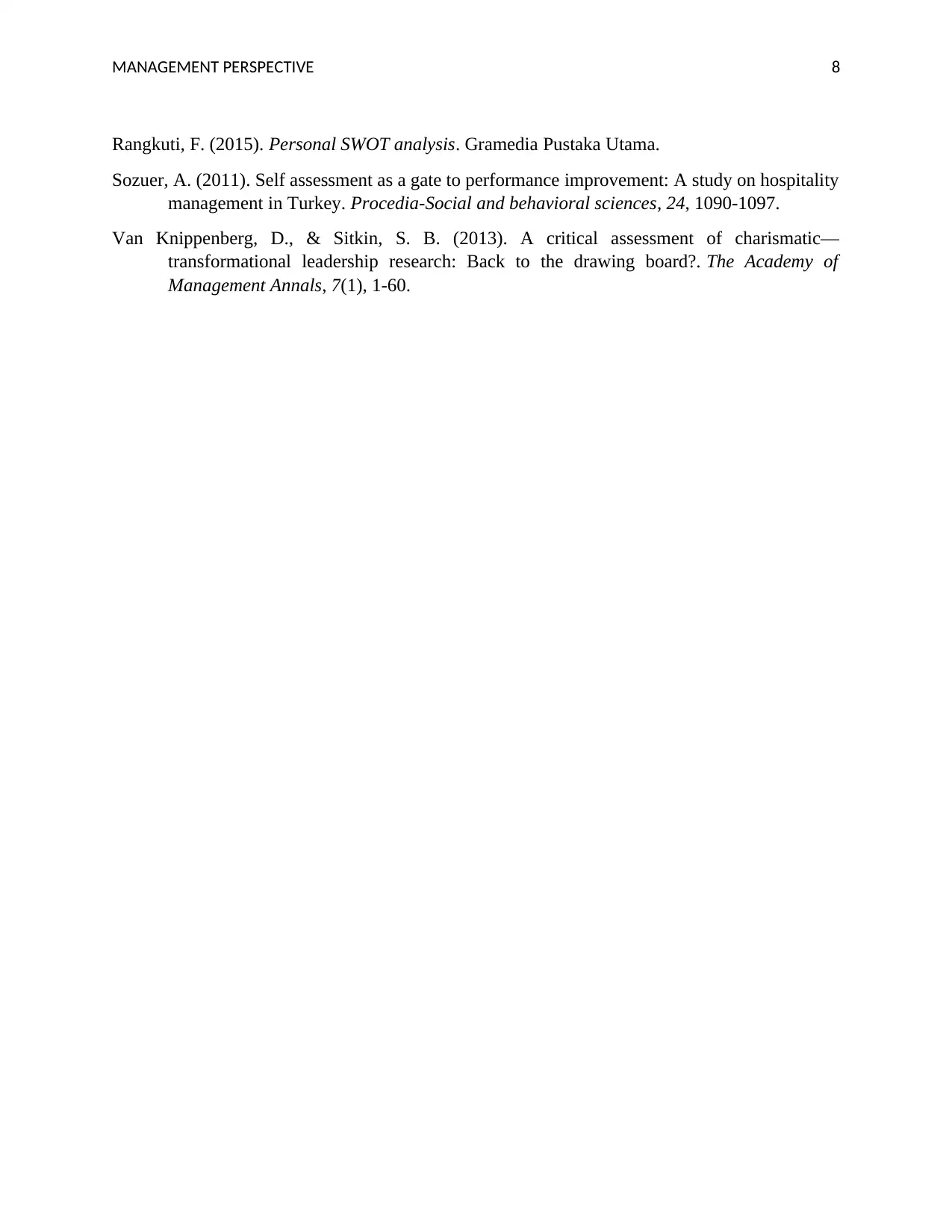
MANAGEMENT PERSPECTIVE 8
Rangkuti, F. (2015). Personal SWOT analysis. Gramedia Pustaka Utama.
Sozuer, A. (2011). Self assessment as a gate to performance improvement: A study on hospitality
management in Turkey. Procedia-Social and behavioral sciences, 24, 1090-1097.
Van Knippenberg, D., & Sitkin, S. B. (2013). A critical assessment of charismatic—
transformational leadership research: Back to the drawing board?. The Academy of
Management Annals, 7(1), 1-60.
Rangkuti, F. (2015). Personal SWOT analysis. Gramedia Pustaka Utama.
Sozuer, A. (2011). Self assessment as a gate to performance improvement: A study on hospitality
management in Turkey. Procedia-Social and behavioral sciences, 24, 1090-1097.
Van Knippenberg, D., & Sitkin, S. B. (2013). A critical assessment of charismatic—
transformational leadership research: Back to the drawing board?. The Academy of
Management Annals, 7(1), 1-60.
1 out of 8
Related Documents
Your All-in-One AI-Powered Toolkit for Academic Success.
+13062052269
info@desklib.com
Available 24*7 on WhatsApp / Email
![[object Object]](/_next/static/media/star-bottom.7253800d.svg)
Unlock your academic potential
Copyright © 2020–2025 A2Z Services. All Rights Reserved. Developed and managed by ZUCOL.





